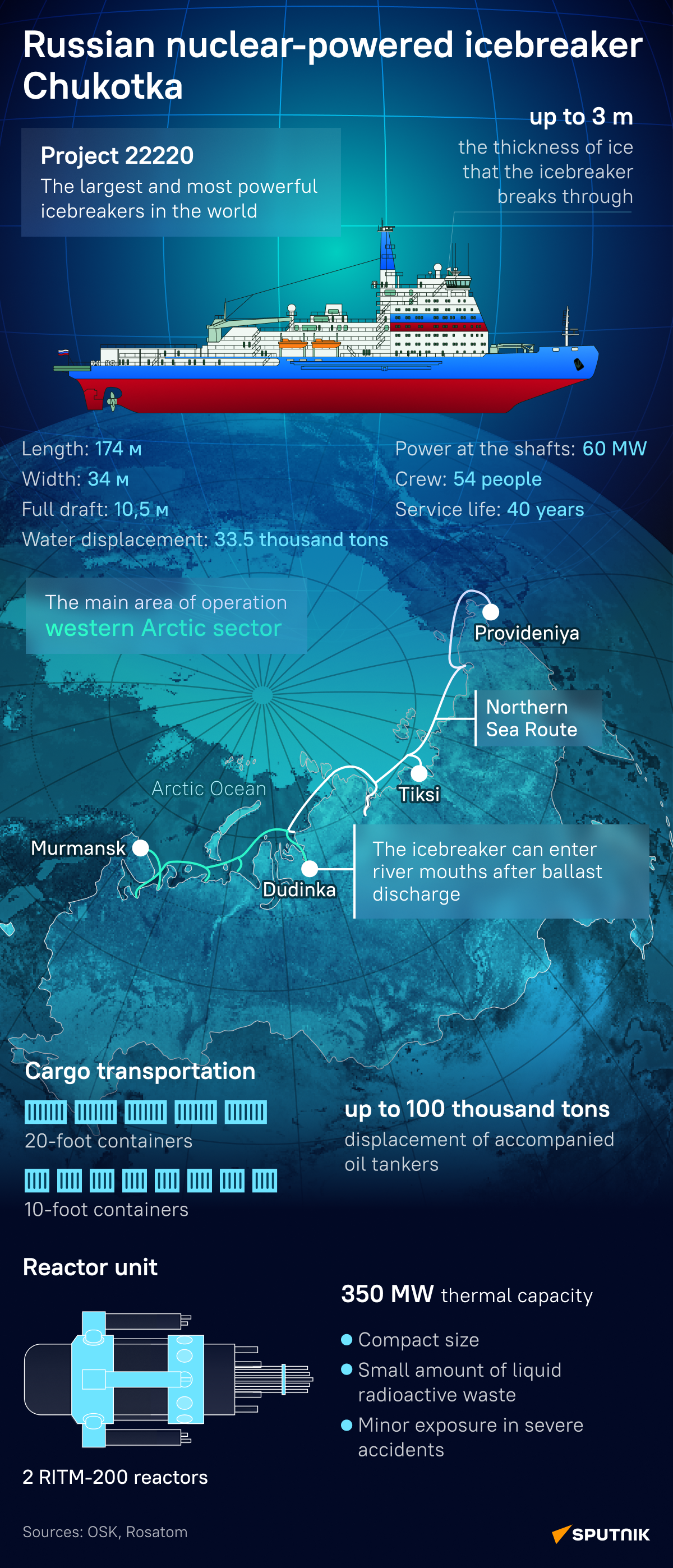https://sputnikglobe.com/20241107/russia-rolls-out-nuclear-powered-icebreaker-chukotka-1120801203.html
Russia Rolls Out Nuclear-Powered Icebreaker Chukotka
Russia Rolls Out Nuclear-Powered Icebreaker Chukotka
Sputnik International
Russia maintains a fleet of nuclear-powered icebreakers that are crucial for ensuring navigable sea routes in the Arctic, especially as climate change opens up new shipping lanes.
2024-11-07T09:57+0000
2024-11-07T09:57+0000
2024-11-07T09:57+0000
multimedia
russia
chukotka
arctic
infographic
icebreaker
icebreakers
https://cdn1.img.sputnikglobe.com/img/07e8/0b/07/1120801929_0:0:1280:720_1920x0_80_0_0_d7bceb3b12407f80a950a2a695c46839.png
On October 6, Russian President Vladimir Putin announced the launch of the nuclear icebreaker Chukotka during a videoconference. The ceremony took place at the Baltic Shipyard in St. Petersburg, Russia, on Wednesday. The Chukotka is part of Russia's Project 22220, which features versatile 60-megawatt twin-axle nuclear icebreakers — the largest and most powerful of their kind in the world.Each icebreaker is outfitted with two RITM-200 reactors. The primary advantage of this reactor unit lies in its compact design and cost-effectiveness, enabling the icebreakers to be structured as twin-axle vessels. This configuration enhances the vessel's technical performance, particularly in terms of speed and ice navigation. Additionally, these units boast a significant energy resource.Launched in 2013, the project has resulted in the construction of three nuclear-powered ships: the lead vessel, Arktika, along with the series ships Sibir and Ural, which have now joined Russia's fleet of nuclear icebreakers.Check out Sputnik's infographic to learn more!
1
russia
chukotka
arctic
Sputnik International
feedback@sputniknews.com
+74956456601
MIA „Rossiya Segodnya“
2024
Sputnik International
feedback@sputniknews.com
+74956456601
MIA „Rossiya Segodnya“
News
en_EN
Sputnik International
feedback@sputniknews.com
+74956456601
MIA „Rossiya Segodnya“
Sputnik International
feedback@sputniknews.com
+74956456601
MIA „Rossiya Segodnya“
russian nuclear-powered icebreaker, nuclear icebreaker chukotka
russian nuclear-powered icebreaker, nuclear icebreaker chukotka
Russia Rolls Out Nuclear-Powered Icebreaker Chukotka
Russia maintains a fleet of nuclear-powered icebreakers that are crucial for ensuring navigable sea routes in the Arctic, especially as climate change opens up new shipping lanes.
On October 6, Russian President Vladimir Putin announced the launch of the nuclear icebreaker Chukotka during a videoconference. The ceremony took place at the Baltic Shipyard in St. Petersburg, Russia, on Wednesday. The Chukotka is part of Russia's Project 22220, which features versatile 60-megawatt twin-axle nuclear icebreakers — the largest and most powerful of their kind in the world.
Each icebreaker is outfitted with two RITM-200 reactors. The primary advantage of this reactor unit lies in its compact design and cost-effectiveness, enabling the icebreakers to be structured as twin-axle vessels. This configuration enhances the vessel's technical performance, particularly in terms of speed and ice navigation. Additionally, these units boast a significant energy resource.
Russia's Project 22220 nuclear-powered icebreakers are designed to escort fleets of ships through Arctic conditions, capable of traversing through ice up to three meters thick. Their primary mission is to facilitate year-round navigation in the western Arctic.
Launched in 2013, the project has resulted in the construction of three nuclear-powered ships: the lead vessel, Arktika, along with the series ships Sibir and Ural, which have now joined Russia's fleet of nuclear icebreakers.
Check out Sputnik's infographic to learn more!



